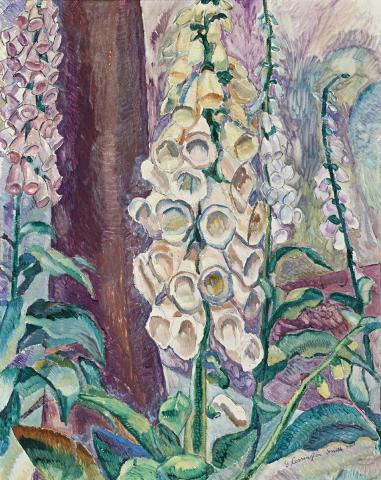FOXGLOVES GROWING, c.1931
Grace Cossington Smith
oil on pulp board
46.5 x 36.5 cm
signed and dated lower right: G. Cossington Smith 1929, signed and inscribed with title on label verso: Foxgloves Growing / Foxgloves Growing /Grace Cossington Smith
Treania Smith, Sydney
Private collection, Sydney
Martin Browne Fine Art, Sydney (label attached verso)
Private collection, Sydney
Grace Cossington Smith, Walker Galleries, London, April 1932
Grace Cossington Smith, Macquarie Galleries, Sydney, 29 May – 8 June 1968, cat. 22
Grace Cossington Smith: Retrospective, Art Gallery of New South Wales, Sydney, National Gallery of Victoria, Melbourne and Art Gallery of Western Australia, Perth, 1973, cat. 33 (label attached verso)
Treania Smith Collection, Painters Gallery, Sydney, 1985, cat. 13
Grace Cossington Smith Survey Exhibition 1919 – 1971, Painters Gallery, Sydney, 8 – 26 September 1987 and Niagara Galleries, 7 – 24 October 1987, Melbourne, cat. 12 (labels attached verso) (illus. in exhibition catalogue p. 7)
The Grace Cossington Smith Loan Exhibition, S.H. Ervin Gallery, Sydney, 18 October – 18 November 1990, cat. 35, held in conjuction with the launch of the book written by Bruce James
Grace Cossington Smith: A Retrospective Exhibition, National Gallery of Australia, Canberra, 4 March – 13 June 2005, touring to Art Gallery of South Australia, Adelaide, Art Gallery of New South Wales, Sydney and Queensland Art Gallery, Brisbane (label attached verso)
James, B., Grace Cossington Smith, Craftsman House, Sydney, 1990, pl. 48, p. 90 (illus.)
Grace Cossington Smith's Foxgloves Growing, c.1929,1 which was painted in her garden at Turramurra, is a characteristic celebration of life, full of light and subtle, gentle colours. Like the best of her flower paintings, it is a work of distinguished beauty. Exhibited in London in 1932, it was included with the finest of her work shown in the revelatory retrospective exhibition curated by Daniel Thomas for the Art Gallery of New South Wales in 1973. While interior views of her home and surrounding garden were her chief source of inspiration, the 1973 exhibition showed that her lively interest ranged across a wide field of subjects. It included paintings of World War I troops marching and an industrial strike of 1917, through colourful moments in the theatre, concerts, horse racing, city scenes, Sydney Harbour Bridge, religious subjects, and an array of landscapes, all marked by that individuality which gives her art such distinction. Paintings seem to shimmer through the mosaic-like application of paint, especially in the use of the brightest of sunlight-like yellows. The everyday never looked so captivating as in Things on a Iron Tray on the Floor, c.1928, in the collection of the Art Gallery of New South Wales. Here, the most prosaic of objects metamorphosed into colour poetry.
In his monograph on Cossington Smith, Bruce James refers to the death of the artist's mother in 1931 and how the elegiac sea paintings at Thirroul gave way to vitalism in a series of flower pieces to which Foxgloves Growing belongs. 'These works exalt Nature', he wrote, 'and the life force in the face of mortality.'2 This is seen in the passionate burst of red in Poinsettias 1931, and the emphasis on new life in both images and titles - Daffodils Growing, Aguilegias Growing, and the painting on offer. A devout Christian, these life-affirming paintings by Cossington Smith make use of colour and composition to express a feeling of inner peace and prayer. The enclosed compositions, for example, with their inner concentration through cropped forms, speak of the internal nature of prayer, private and personal. Their colours have both symbolic (red the traditional colour for the Holy Spirit) and emotional connotations; while their overall beauty touches upon enlightenment. Flowers are among the most beautiful things in nature. As the Bible reminds us, 'Consider the lilies of the field, how they grow; they toil not, neither do they spin: And yet I say unto you, That even Solomon in all his glory was not arrayed like one of these.'3 A great flower painter is a rare gift to any country.
1. The correct date is understood to be 1931, Daniel Thomas having stated in the 1973 retrospective exhibition catalogue, page 12, that the '1929' date was added later.
2. James, B., Grace Cossington Smith, Craftsman House, Sydney, 1990, pp. 87, 90
3. St Matthew, ch.6, v.33
DAVID THOMAS
